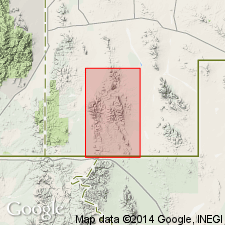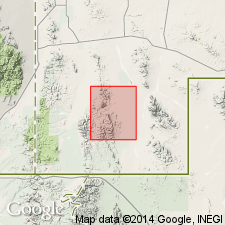
- Usage in publication:
-
- Pine Canyon Formation
- Modifications:
-
- First used
- Dominant lithology:
-
- Latite
- AAPG geologic province:
-
- Pedregosa basin
Summary:
First use of name. On geologic map only. Probably named for Pine Canyon, sec 1, T32S, R19W, Walnut Wells quad, Hidalgo Co, NM in Pedregosa basin near which it is well exposed. No type locality designated. Composed of latitic flows and agglomerate; in part, equivalent to OK-Bar Conglomerate and Double Adobe Latite (both new). Is younger than Park Tuff (new). Is of Tertiary age.
Source: GNU records (USGS DDS-6; Denver GNULEX).

- Usage in publication:
-
- Pine Canyon Formation
- Modifications:
-
- Named
- Dominant lithology:
-
- Porphyry
- Latite
- AAPG geologic province:
-
- Pedregosa basin
Summary:
Named for Pine Canyon, sec 1, T32S, R19W, Walnut Wells quad, Hidalgo Co, NM in Pedregosa basin near which it is well exposed. No type locality designated. Mapped. Originally interpreted as an upper flow facies of Park Tuff (new) due to the similar appearance of the two units, and their similar relationships to other units. Further study proved that this unit intertongues with and is equivalent to Double Adobe Latite (new). Flow breccia and agglomerate indicate is of flow origin. Consists of latite; has flow banding. Source area is headwaters of Pine Canyon where unit attains greatest thickness (several hundred ft). Weathers here into high, prominent, white pinnacles. South and east of source area, unit is removed by erosion. This rapidly to north where it intertongues with Double Adobe. West of Adobe Creek Well (sec 3, T31S, R19W) where these beds are intertongued with Double Adobe Latite, rock consists of porous and banded flow breccia and agglomerate. Here planar flow structures dip sharply northward and rest on a nearly horizontal sandstone of OK-Bar Conglomerate. Overlies OK-Bar; intertongues with and is equivalent to Double Adobe Latite. Is Tertiary in age.
Source: GNU records (USGS DDS-6; Denver GNULEX).
For more information, please contact Nancy Stamm, Geologic Names Committee Secretary.
Asterisk (*) indicates published by U.S. Geological Survey authors.
"No current usage" (†) implies that a name has been abandoned or has fallen into disuse. Former usage and, if known, replacement name given in parentheses ( ).
Slash (/) indicates name conflicts with nomenclatural guidelines (CSN, 1933; ACSN, 1961, 1970; NACSN, 1983, 2005, 2021). May be explained within brackets ([ ]).

